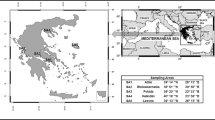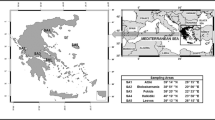Abstract
The substantial complexity in ecosystem–radionuclide interactions is difficult to be represented in terms of radiological doses. Thus, radiological dose assessment tools use typical exposure situations for generalized organisms and ecosystems. In the present study, site-specific data and radioactivity measurements of terrestrial organisms (grass and herbivore mammals) and abiotic components (soil) are provided. The retrieved data are used in combination with the ERICA Assessment Tool for calculation of radiological parameters. The process of radionuclide transfer within ecosystem components is represented using concentration ratios (CRs), while for the calculation of dose rates the dose conversion coefficient (DCC) methodology is applied. Comparative assessments are performed between the generic and assessment-specific radiological parameters and between the resulting dose rates. Significant differences were observed between CRs calculated in this study and those reported in the literature for cesium and thorium, which can easily be explained. On the other hand, CRs calculated for radium are in very good agreement with those reported in the literature. The DCCs exhibited some small differences between the reference and the assessment-specific organism due to mass differences. The differences were observed for internal and external dose rates, but they were less pronounced for total dose rates which are typically used in the assessment of radiological impact. The results of the current work can serve as a basis for further studies of the radiological parameters in environments that have not been studied yet.





Similar content being viewed by others
References
Aliyu AS, Ramli AT, Garba NN, Saleh MA, Gabdo HT, Liman MS (2015) Fukushima nuclear accident: preliminary assessment of the risks to non-human biota. Radiat Prot Dosim 163(2):238–250
Amiro BD (1997) Radiological dose conversion factors for generic non-human biota used for screening potential ecological impacts. J Environ Radioact 35:37–51
Beresford NA, Barnett CL, Howard BJ, Scott WA, Brown JE, Copplestone D (2008) Derivation of transfer parameters for use within the ERICA Tool and the default concentration ratios for terrestrial biota. J Environ Radioact 99:1393–1407
Biermans G, Horemans N, Vanhoudt N, Vandenhove H, Saenen E, Hees MV, Wannijn J, Vives i Batlle J, Cuypers A (2014) An organ-based approach to dose calculation in the assessment of dose-dependent biological effects of ionising radiation in Arabidopsis thaliana. J Environ Radioact 133:24–30
Brown JE, Alfonso B, Avila R, Beresford NA, Copplestone D, Hosseini A (2016) A new version of the ERICA Tool to facilitate impact assessments of radioactivity on wild plants and animals. J Environ Radioact 153:141–148
Copplestone D, Beresford NA, Brown JE, Yankovich T (2013) An international database of radionuclide concentration ratios for wildlife: development and uses. J Environ Radioact 126:288–298
ERICA (2016) The ERICA Assessment Tool: environmental risk from ionizing contaminants: assessment and management (version 1.2.1, February 2016). Help Function Document. http://www.erica-tool.eu. Accessed 15 Oct 2016
Giourga H, Margaris NS, Vokou D (1998) Effects of grazing pressure on succession process and productivity of old fields on Mediterranean islands. Environ Manag 22(4):589–596
Gomez-Ros JM, Pröhl G, Ulanovsky A, Lis M (2008) Uncertainties of internal dose assessment for animals and plants due to non-homogeneously distributed radionuclides. J Environ Radioact 99:1449–1455
Howard BJ, Beresford NA, Copplestone D, Telleria D, Pröhl G, Fesenko S, Jeffree RA, Yankovich TL, Brown JE, Higley K, Johansen MP, Mulye H, Vandenhove H, Gashchak S, Wood MD, Takata H, Andersson P, Dale P, Ryan J, Bollhöfer A, Doering C, Barnett CL, Wells C (2013) The IAEA handbook of radionuclide transfer to wildlife. J Environ Radioact 121:55–74
IAEA (1989) Measurements of radionuclides in food and the environment: a guidebook. Technical report series no. 295. International Atomic Energy Agency, Vienna
IAEA (2010) Handbook of parameter values for the prediction of radionuclide transfer in terrestrial and freshwater environments. Technical report series no. 472. International Atomic Energy Agency, Vienna
IAEA (2014) Handbook of parameter values for the prediction of radionuclide transfer to wildlife. Technical report series no. 479. International Atomic Energy Agency, Vienna
ICRP (2008) Environmental protection: the concept and use of reference animals and plants. ICRP Publication 108. Ann ICRP 38(4–6):1–237
ICRP (2009) Environmental protection: transfer parameters for reference animals and plants. ICRP Publication 114. Ann ICRP 39(6):1–113
Johansen MP, Twining JR (2010) Radionuclide concentration ratios in Australian terrestrial wildlife and livestock: data compilation and analysis. Radiat Environ Biophys 49:603–611
Joint Research Center (JRC) (2001) European Soil Database. TEXT-SRF-DOM: dominant surface textural class of the STU. Soil Geographical Database of Eurasia. http://eusoils.jrc.ec.europa.eu/. Accessed 09 June 2015
Klement AW (1982) Handbook of environmental radiation. CRC series in radiation measurement and protection. CRC Press Inc., Boca Raton
Kritidis P, Florou H, Eleftheriadis K, Evangeliou N, Gini M, Sotiropoulou M, Diapouli E, Vratolis S (2012) Radioactive pollution in Athens, Greece due to the Fukushima nuclear accident. J Environ Radioact 114:100–104
Linsalata P, Morse R, Ford H, Eisenbud M (1989) Transport pathways of Th, U, Ra and La form soil to cattle tissues. J Environ Radioact 10:115–140
Linsalata P, Morse R, Ford H, Eisenbud M (1991) Th, U, Ra and rare earth element distributions in farm animal tissues from an elevated natural radiation background environment. J Environ Radioact 14:233–257
Marshall K, Watson S, McDonald P, Copplestone D, Watts SJ (2010) Exposure of birds to radionuclides and other contaminants in special protection areas (SPAs) in North-West England. Sci Total Environ 408:2567–2575
Mazeika J, Marciulioniene D, Nedveckaite T, Jefanova O (2016) The assessment of ionising radiation impact on the cooling pond freshwater ecosystem non-human biota from the Ingalina NPP operation beginning to shut down and initial decommissioning. J Environ Radioact 151:28–37
Pentreath RJ (1999) A system for radiological protection of the environment: some initial thoughts and ideas. J Radiol Prot 19(2):117–128
Pentreath RJ (2009) Radioecology, radiobiology and radiological protection: frameworks and fractures. J Environ Radioact 100:1019–1026
Pentreath RJ, Woodhead DD (2001) A system for protecting the environment from ionising radiation: selecting reference fauna and flora, and the possible dose models and environmental geometries that could be applied to them. Sci Total Environ 277:33–43
Pröhl G, Brown J, Gomez-Ros JM, Jones S, Taranenko V, Thørring H, Vives i Batlle J, Woodhead D (2003) Dosimetric models and data for assessing radiation exposure to biota. Deliverable 3 to the Project “FASSET—Framework for Assessment of Environmental Impact” (Contract No. FIGE-CT-2000-00102)
Reinardy HC, Teyssie J-L, Jeffree RA, Copplestone D, Henry TB, Jha AN (2011) Uptake, depuration and radiation dose estimation in zebrafish exposed to radionuclides via aqueous or dietary routes. Sci Total Environ 409:3771–3779
Sotiropoulou M, Florou H, Manolopoulou M (2016) Radioactivity measurements and dose rates calculations using ERICA Tool in the terrestrial environment of Greece. Environ Sci Pollut Res 23(11):10872–10882
Taranenko V, Pröhl G, Gómez-Ros JM (2004) Absorbed dose rate conversion coefficients for reference terrestrial biota for external photon and internal exposures. J Environ Radioact 24:35–62
Ulanovsky A, Pröhl G, Gómez-Ros JM (2008) Methods for calculating dose conversion coefficients for terrestrial and aquatic biota. J Environ Radioact 99:1440–1448
US-DOE (1997) Environmental measurements laboratory, procedures manual, HASL-EML-300, 28th edn. U.S. Department of Energy, New York
US-DOE (2002) A graded approach for evaluating radiation doses to aquatic and terrestrial biota. U.S. Department of Energy, Washington, DC
US-NRC (2003) Literature review and assessment of plant and animal transfer factors used in performance assessment modeling. U.S. Nuclear Regulatory Commission, Washington, DC
Vetikko V, Kostiainen E (2013) Assessment of doses to game animals in Finland. J Environ Radioact 125:69–73
Vetikko V, Saxén R (2010) Application of the ERICA Assessment Tool to freshwater biota in Finland. J Environ Radioact 101:82–87
Wood MD, Marshall WA, Beresford NA, Jones SR, Howard BJ, Copplestone D, Leah SR (2008) Application of the ERICA Integrated Approach to the Drigg coastal sand dunes. J Environ Radioact 99:1484–1495
Yankovich T, Beresford N, Wood M, Aono T, Andersson P, Barnett C, Bennett P, Brown J, Fesenko S, Fesenko J, Hosseini A, Howard BJ, Johansen MP, Phaneuf M, Tagami K, Takata H, Twining JR, Uchida S (2010) Whole-body to tissue concentration ratios for use in biota dose assessments for animals. Radiat Environ Biophys 49:549–565
Yu C, Cheng J-J, Kamboj S (2013) Effects of the new wildlife transfer factors on RESRAD-BIOTA’s screening biota concentration guides and previous model comparison studies. J Environ Radioact 126:338–351
Acknowledgements
The authors wish to thank the reviewers for their valuable contribution to the improvement of this paper.
Author information
Authors and Affiliations
Corresponding author
Ethics declarations
Conflict of interest
The authors declare that they have no conflict of interest.
Rights and permissions
About this article
Cite this article
Sotiropoulou, M., Florou, H. & Kitis, G. Calculating the radiological parameters used in non-human biota dose assessment tools using ERICA Tool and site-specific data. Radiat Environ Biophys 56, 443–451 (2017). https://doi.org/10.1007/s00411-017-0703-8
Received:
Accepted:
Published:
Issue Date:
DOI: https://doi.org/10.1007/s00411-017-0703-8




